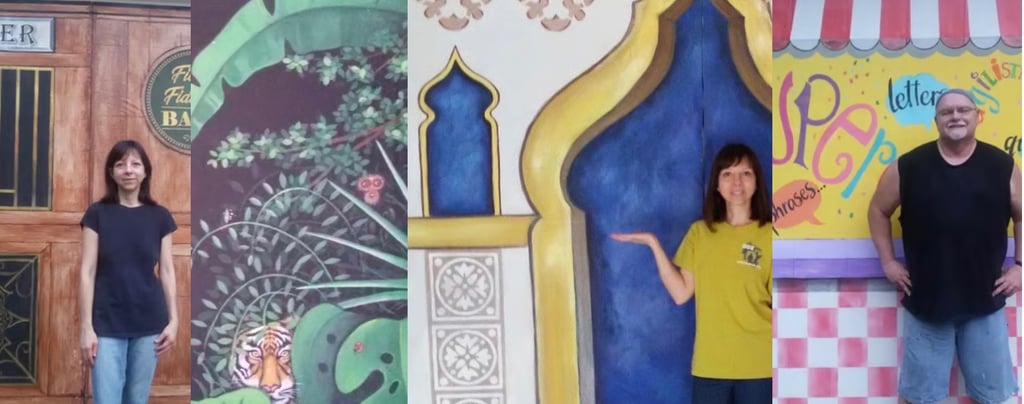Backdrop Stories: Lessons in Scale, Story, and Shared Brushstrokes
The first time I painted a theatrical backdrop, I was facing a canvas bigger than anything I’d worked on before—eight feet tall, stretching wide across the floor. It wasn’t hanging delicately on a wall or sitting quietly on an easel. This canvas was part of a live world in motion...
Gabriela Hogue
6/6/20252 min read
The first time I painted a theatrical backdrop, I was facing a canvas bigger than anything I’d worked on before—eight feet tall, stretching wide across the floor. It wasn’t hanging delicately on a wall or sitting quietly on an easel. This canvas was part of a live world in motion.
I had painted large pieces before, but this was different. The backdrop wouldn’t be viewed in a calm gallery or a cozy room. It would be seen from a distance, under shifting lights, behind actors in costume. My usual fine details? Irrelevant. My usual pace? Too slow.
Actually, the reason I had the opportunity to paint theater backdrops at all was thanks to my husband. He taught drama for many years, and when he was putting on a play, we would create the backdrops together. He’s a very talented artist himself, and we were both equally involved in the painting—sketching, blocking in color, making creative decisions, and bringing the set to life.
Over the years, we worked on productions like Aladdin, Annie, Jungle Book, and Mary Poppins. Each play came with its own imaginative world, and we loved the challenge of bringing those settings to life in paint.
We made a great team—him directing the stage and story, both of us painting the world behind it. We’d spend late nights working side by side, sometimes in total concentration, sometimes laughing through unexpected spills or last-minute changes. It was one of those quiet collaborations that I’ll always cherish—art and partnership woven into one big canvas.
To make it work, I had to let go. I started moving faster, using wider brushes, making bolder choices. I stopped obsessing over precision and started trusting the flow. In theater, everything is temporary, and that truth gave me freedom. Paint could bleed. Edges could soften. What mattered most was the feeling—the atmosphere—I was creating.
I learned to think in mood and motion. Instead of painting a scene, I was painting a world. A background that would hold emotion, hint at a setting, and quietly support a story unfolding in front of it. It was humbling—and thrilling—to realize my work wasn’t the main character, but it was essential.
The lessons stayed with me long after the performances ended. I returned to my studio with new eyes. Suddenly, I wasn’t afraid of scale or blank space. I felt more confident about color, flow, and even starting without a plan. Theatrical painting taught me to loosen my grip—to trust the process and the purpose, even when it’s bigger than me.
Now, when I face a new canvas, I sometimes catch myself holding the brush like I did on stage: loose, brave, and ready to move.
💬 What about you?
Have you ever created something that was meant to disappear—or be part of something bigger? I’d love to hear your story.


